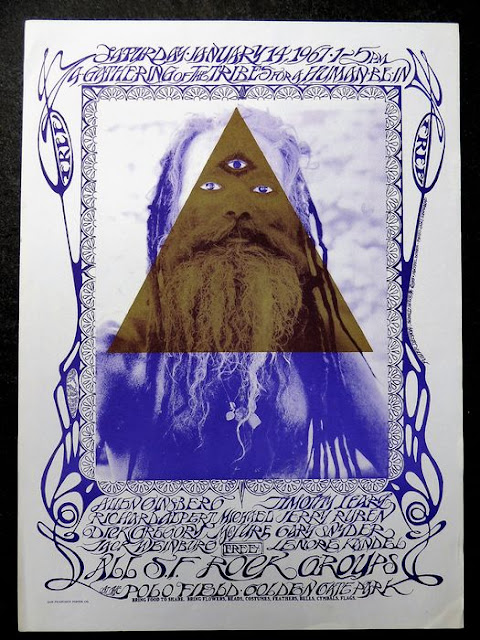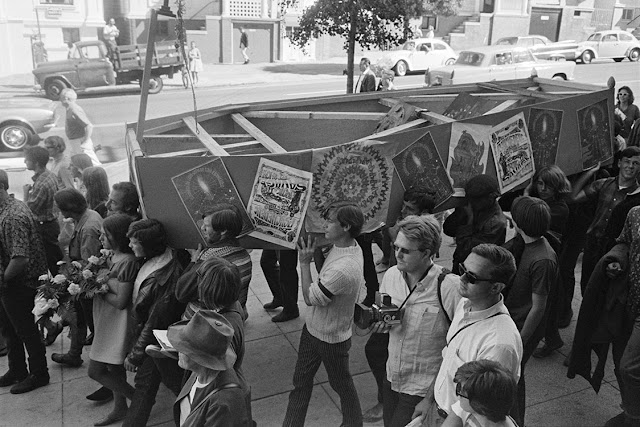A poster promoting the Human Be-in at San Francisco's Golden Gate Park.
It has been dubbed it birth of the Hippie Era. It was more like a coming out party for a counterculture that had been developing in the Bay Area for more than a decade.
The Human Be-In held on January 14, 1967 in San Francisco’s Golden Gate Park attracted as many as 20,000 people and got the attention of the national media as nothing else before it. That night’s network television news shows featured film of the event that beamed into perplexed homes across the country. That semi-official reflection of American culture, Life magazine affirmed its significance with a photo spread.
Soon Scott McKenzie’s Are You Coming to San Francisco? would hit the air waves and kids from across the continent would head to Haight-Ashbury for the Summer of Love. By spring similar events were popping up around the country.
Chicago’s first Be-In was held at The Point near the 57th Street Beach by Hyde Park in April. But the one on May 14 in Lincoln Park and promoted by the Seed turned into a regular event every Sunday that year and again the following summer right up to when the park was taken over for the Democratic Convention protests in August.
The Human Be-In was the inspiration of artist and San Francico Oracle founder Michael Bowen.The catalyst for the event was a new California law which went into effect in October 1966 which made the possession and use of LSD a crime for the first time. Brown envisioned an event where the law would be challenged by massive, open defiance. He created the term Human Be-In as a synthesis of Humanism and the civil disobedience of Civil Rights Movement lunch counter sit-ins.
Bowen's classic cover creation for the Oracle.The event was promoted heavily in the Oracle as A Gathering of the Tribes and featured on the cover of its fifth edition printed in an eye-catching purple ink. Flyers and posters distributed at music venues like the Fillmore, Beat coffee houses and bookstores, and on the streets generated excitement.
The program was impressive. Beat mainstays Allan Ginsberg and Gary Snyder were on hand to lend support and lead meditations. Former Harvard professor Dr. Timothy Leary, already famous for his advocacy of LSD, made his first West Coast appearance and for the first time urged his audience to “tune in, turn on, and drop out.” With him was his associate Richard Alpert, who would soon emerge as the guru Ram Das.
Gary Snyder, Michael McClure, Allen Ginsberg, Freewheelin’ Frank, and Marcetta lead chanting at the Human Be-In.Radical political figures including the comedian/Civil Rights activist Dick Gregory and student organizer Jerry Rubin spoke. The only woman on the program, Lenore Kandel, read erotic poetry from The Love Book, her four poem pamphlet that was at the center of a celebrated censorship case.
Although the catch phrase had not yet been coined the Human Be-In was all about sex, drugs, and rock & roll plus a dash of mysticism and of revolution.The program was energized by performances by some of the top bands of the emerging psychedelic rock scene—Jefferson Airplane, Quicksilver Messenger Service, and The Grateful Dead.
Hell’s Angels were on hand to provide “security” and even conducted an operation to reunite lost children with their parents. Hugh Romney and the Hog Farm were there to provide food—brown rice and veggies. All of the classic elements of the counter culture were gathered together for the first time in one event.
A rare photo of underground chemist Owsley who brought thousands of hits of pure and potent acid to the Be-In.Most critically, the guerrilla chemist Owsley Stanley brought thousands of doses of powerful White Lighting Acid which he had manufactured just for the occasion and which was distributed freely to the crowd.
Inspired by the Be-In and Scott McKenzie’s song more than 100,000 kids descended on the overwhelmed Haight. Despite the best efforts of locals to accommodate them, most ended up on the street and many were prey for sexual exploitation, violence, and hard drugs like heroin. By Fall the organizers of the Be-In were eager to send a new message—don’t come to San Francisco. Instead they wanted to young people to stay in their own towns and create community and social movements there.
Less than ten months after the Human Be-In the community staged a Death of the Hippy mock funeral to discourage the hoards of young people who had descended on the Haight during the Summer of Love.So on October 6, 1967 The Death of the Hippie was staged as a mock funeral in the Haight.
By that time, however, pop culture had appropriated Hippie and characters were popping up on television shows and in movies. Rowan and Martin’s Laugh-In premiered in January 1968.
In the boonies, kids still wanted to be Hippies. They grew their hair long, smoked dope, dropped acid, and listened endlessly to rock and roll. At the same time the escalating Viet Nam War and police repression of protests were radicalizing many. In early ’68 Rubin and Abbie Hoffman would create the Yippies out of thin air to politicize the counter culture as never before.
The rest, as they say, is history.







No comments:
Post a Comment